Curbing inflation has become the top priority
The Chinese economy is still maintaining relatively high growth, although it has slowed somewhat. Meanwhile, inflation has been accelerating, and stabilizing prices has become the top policy priority, in lieu of sustaining growth.
Following the collapse of Lehman Brothers, China suffered from a sharp decline in exports and experienced a temporary drop in growth. In response, the Chinese government adopted expansionary fiscal and monetary policies, including a stimulus package of over four trillion yuan. Thanks to these initiatives, the Chinese economy has recovered ahead of developed nations. The growth rate (real, year on year, the same applies below), which fell to 6.5% in the first quarter of 2009, rebounded to 11.1% in the first half of 2010 (11.9% in the first quarter and 10.3% in the second quarter), returning to double-digit growth once again. Meanwhile, the inflation rate (year on year, the same applies below) rose to 4.7% in the fourth quarter of 2010, which caused the authorities to gradually shift their monetary policy from easing to tightening. With the effect of the stimulus package fading, the growth rate fell to 9.7% in the second half of 2010 (with 9.6% in the third quarter and 9.8% in the fourth quarter). Still, the annual growth rate in 2010 was 10.3%, exceeding 9.2% in 2009. By demand component, while domestic demand components such as consumption and investment are slowing, net exports are picking up amid the recovering global economy, which has pushed up the growth rate (Figure 1).
| Figure 1: Changes in Contributions of Major Demand Components to GDP Growth | |
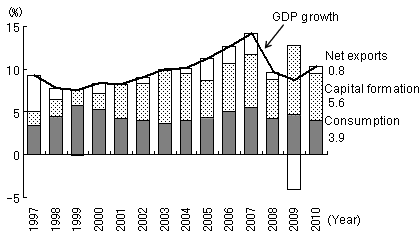 | |
| (Note) | Capital formation includes an increase in inventory (inventory investment). |
| (Source) | Prepared by Chi Hung KWAN, based on the China Statistics Summary 2010 of the National Bureau of Statistics of China and press release (on January 20, 2011) of the National Bureau of Statistics of China |
Looking at economic trends after the Lehman Brothers failure, focusing on the growth rate and the inflation rate, we notice that the Chinese economy entered a period of high growth and high inflation (overheating) in 2010 after experiencing low growth and high inflation (stagflation) in the second half of 2008, low growth and low inflation (recession) in the first half of 2009, and high growth and low inflation (recovery) in the second half of 2009 (Figure 2). In China, the inflation rate has traditionally been linked to the growth rate, lagging behind the latter by three quarters. Based on this trend, it is likely that the inflation rate will decline from here on with the fourth quarter of 2010 as its peak, given that growth peaked in the first quarter of 2010 and slowed after that (Figure 3).
| Figure 2: Various Stages of the Chinese Economy after the Lehman Shock: Changes in GDP growth and inflation | |
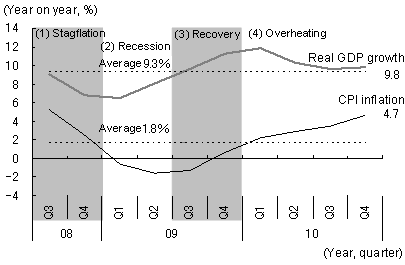 | |
| (Note) | (1) low growth and high inflation; (2) low growth and low inflation; (3) high growth and low inflation; and (4) high growth and high inflation |
| (Source) | Prepared by Chi Hung KWAN, based on the CEIC Database |
| Figure 3: Inflation lagging behind GDP Growth | |
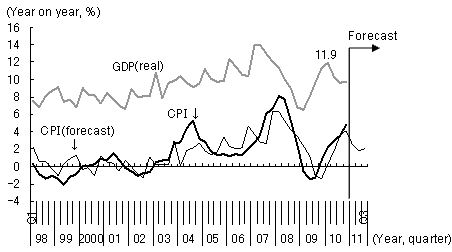 | |
| (Note) | Estimated values of CPI are based on regression analysis. Estimation period: The first quarter (Q1) of 1998 to the fourth quarter (Q4) of 2010 |
| (Source) | Prepared and estimated by Chi Hung KWAN, based on the CEIC Database. |
In addition to the slowdown of the economy, the restrictive monetary policies taken by the authorities also helped stave off inflation. First, the reserve requirements have been raised seven times since 2010, to reach a record high of 19.0% at present. Also, the base rates of banks for deposits and lending were raised twice, in October 2010 and December 2010, by 0.5 percentage points in total. In addition, revaluation of the yuan, which had been temporarily halted due to the global financial crisis, resumed in June 2010, and since then, it has been rising around 6% against the dollar at an annual rate. Following this, the growth rate (year on year) in money supply (M2), which peaked at 29.7% (November 2009), has remained below 20% since June 2010, while inflation has been falling from 5.1% in November, the highest level since July 2008, to 4.6% in December.
With economic growth slowing down and inflation peaking out but still at a high level, the Chinese economy appears poised to shift from the stage of high growth and high inflation (overheating) to low growth and high inflation (stagflation) (Figure 4). In the second half of 2011, the Chinese economy is expected to enter the stage of low growth and low inflation (recession), with inflation beginning to cool. At that stage, there will be room for monetary easing.
| Figure 4: Cyclical Changes in GDP Growth and Inflation after the Lehman Shock | |
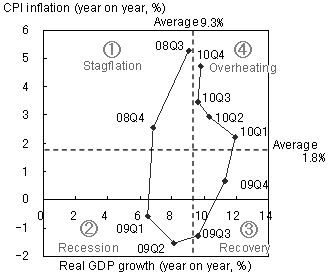 | |
| (Note) | (1) low growth and high inflation; (2) low growth and low inflation; (3) high growth and low inflation; and (4) high growth and high inflation. The economy circulates counterclockwise in the order of (1)>(2)>(3)>(4)>(1). |
| (Source) | Prepared by Chi Hung KWAN, based on the CEIC Database. |
Political business cycle draws attention
Apart from the inflation outlook, the political calendar in the years ahead will also become an important factor that influences the economy.
The Chinese economy has followed a five-year cycle, which might be called a "political business cycle," with the Communist Party Congress as the key player. A pattern in which economic growth hits bottom in the years before the Party Congress, and peaks in the year of the Party Congress, has become quite established in China. The trend has been even stronger in recent years. While average GDP growth in China from 1981 to 2010 has been 10.1%, it has been higher, at 11.3%, in years when the Party Congress is held. Indeed, GDP growth reached 14.2% in 2007 when the Party Congress was last held (Figure 5).
| Figure 5: Business Cycle in China linked to the Communist Party Congress: Changes in GDP growth | |
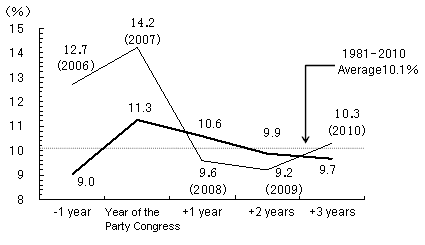 | |
| (Note) | The thick line shows the average growth rates for the years specified (in the period between 1981 and 2010). For example, the growth rate for the "Year of the Party Congress" shows the average for 1982, 1987, 1992, 1997, 2002 and 2007. The thin line shows the growth rate in each year from 2006. The Party Congress is held every five years, and the previous (17th) Party Congress was held in October 2007. |
| (Source) | Prepared by Chi Hung KWAN, based on data of the National Bureau of Statistics of China. |
The reason why the business cycle in China has become a kind of political business cycle and why this trend has been strengthening is that the political system has been changing. In other words, after politicians of the revolutionary generation represented by Mao Zedong and Deng Xiaoping faded from the limelight, the Communist Party faced no choice but to find legitimacy in improving national income through economic growth, rather than relying on the charisma of its leaders. Therefore, expansionary macroeconomic policies tend to be pursued, in line with the holding of the Party Congress, the major political event that decides important personnel affairs. The fact that economic growth becomes a focus as an indicator for evaluating and selecting Party cadres and government officials at not only the central level but also the local level only serves to accelerate this trend.
At the Fifth Plenary Session of the Party's 17th Central Committee held in October 2010, Vice President Xi Jinping was appointed Vice-Chairman of the Central Military Commission and solidified his position as successor to President Hu Jintao, the General Secretary of the Communist Party and the Chairman of the Central Military Commission. At the 18th Party Congress to be held in fall 2012, the terms of office of Hu Jintao as the General Secretary of the Communist Party for two terms covering ten years in total will expire, and the Party leadership will be changed. The highest ranks of government, including the president and the premier, are to be replaced at the National People's Congress in March 2013. In keeping with this political calendar, expansionary fiscal and monetary policies are expected. In response, the Chinese economy is likely to recover in earnest in 2012.


